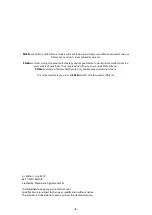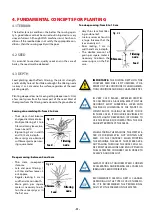
- 11 -
- 11 -
4. FUNDAMENTAL CONCEPTS FOR PLANTING
4.1 TERRAIN
The better terrain conditions, the better the sowing quali-
ty. A good labour cannot be carried out in big clods or very
uneven furrows. Although SOLÀ machines resist harsh con-
ditions, if the seedbed does not satisfy the appropriate con-
ditions, then the sowing quality will be poor.
4.2 SEED
It is essential to use clean, quality seeds and, in the case of
barley, the seed must be deburred.
4.3 DEPTH
Seed planting depth affects tillering, the plant’s strength,
and its ability to resist frostbite or drought: the tillering node
is always 1 or 2 cm under the surface, regardless of the seed
planting depth.
Planting deeper does not mean getting deeper roots. Only
a few roots grow from the lower part of the seed. Most of
them grow from the tillering node closer to the ground level.
Sowing at normal depth: from 2 to 4 cm
Fig. 4.1
Fig. 4.1
Seed
Seed
Tillering
Tillering
node
node
• Thick stem, short rhizome
and good resistance to ice.
• Multiple tillering of 3 to 6
tiles and many leaves, be-
tween 6 and 10.
• Big rooting, 5 cm in width
and 10-12 cm in depth.
• More sprigs are obtained
with fewer grains per sow-
ing square meter.
Deeper sowing: between 5 and 6 cm
Fig. 4.2
Fig. 4.2
Seed
Seed
Rhizome
Rhizome
Tillering
Tillering
node
node
• Thin stem, ice-exposed
rhizome
• Late and poor tillering, 1
or 0 tiles and few leaves, 3
or 4 approx.
• Regular rooting, 3 cm in
width and 5 cm in depth.
• More grain per square
meter is necessary to ob-
tain the same sprigs as in
the first case.
Too deep sowing: from 8 to 10 cm
Fig. 4.3
Fig. 4.3
Rhizome
Rhizome
Seed
Seed
Tillering
Tillering
node
node
• Very thin stem. Not tiller-
ing and one leaf.
• Grain reserves exhaust in
a large rhizome that the
ice can easily cut.
• Poor rooting, 1 cm in
width and 3 cm in depth.
• The double amount of
grain per square meter is
necessary to obtain the
same sprigs as in the first
case.
IMPORTANTE:
THE SOWING DEPTH ON TINE
COULTERS SEED DRILL ISN’T UNIFORM, IT DE-
PENDS ON THE CONDITIONS OF HOMOGENIZA-
TION CONDITIONS AND FIELD CHARACTERISTICS.
IN VERY COLD PLACES, REPEATED FROSTBI-
TE CAN PRODUCE A BULKING EFFECT ON THE
GROUND’S MOST SUPERFICIAL LAYER WITH
THE RISK OF LOOSENING AT THE PLANT’S IN-
CIPIENT ROOTS, CAUSING THE PLANT TO DIE.
IN THESE CASES, IT WOULD BE ADVISABLE TO
PLANT SLIGHTLY DEEPER AND, IF POSSIBLE, TO
USE THE ROLLER FOR COMPACTING THE SOIL
AND BETTER PROTECT THE SEEDS.
WHEN STARING THE MACHINE, THE FIRST ME-
TER OF FURROWS WILL NOT CONTAIN ANY
SEED. ON THE CONTRARY, WHEN STOPPING
THE MACHINE, THE SEEDS THAT WERE ALRE-
ADY FALLING THROUGH THE HOSES WILL SLI-
DE FROM THE MACHINE AND END UP PILED IN
THE LAST METER. CONSIDER THIS IN ORDER TO
ACHIEVE A GOOD RESULT.
ALWAYS WORK AT UNIFORM SPEED. SUDDEN
ACCELERATING AND BRAKING WILL CAUSE AN
IRREGULAR SEED DISTRIBUTION.
RECOMMENDED SEEDING DEPTH CHANGES
DEPENDING ON THE TYPE OF CROP, THEREFO-
RE, IT IS RECOMMENDED THE PROFESSIONAL
ADVICE TO THE FARMER ON THISMATTER.






























